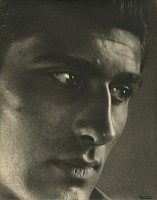BIOGRAPHY

Helmar Lerski was born Israel Schmuklerski on February 18, 1871 just after the Franco-Prussian War in Strasbourg, which was then Germany. He was a son of Polish emigrants who moved the family in 1876 to Switzerland, just outside Zürich. Initially, he followed his father’s wishes and worked at a bank but left for Chicago in 1893 just before his 22nd birthday and became an actor in the German Theater Company in Milwaukee. He changed his name at some point during the next five years since in 1897 there was a notice for the Irving Place Theater in New York that listed him as Helmar Lerski. He must have also taken up photography around this time since by 1910 he was listed in the City Directory of Milwaukee as a photographer. His earliest known photographs are of musicians and fellow actors and by 1912 his work was included at the annual convention of the Photographer’s Association of America in Philadelphia, in German language newspapers of Milwaukee, and in American photography magazines. In 1913 he demonstrated his lighting techniques at the Photographer’s Association of America convention in Kansas City and was included in the London Salon of Photography. From 1914-15, he spent a term in the German Department of the University of Texas at Austin.
Lerski returned to Europe in 1915 and settled in Berlin where he had the first exhibition of his work. He worked as a cameraman and photographer for W.W. Film Company (William Wauer) and later as director of cinematography at the Deutsche Bioscop GmbH as a member of Robert Reinert’s production team who employed him through 1921. Through 1927, he worked for several other production companies on films including Fritz Lang’s Metropolis. Around 1928 Lerski focused his attention to photographing the intelligentsia of Berlin’s cultural scene and the work was published in 1931 as Köpfe des Alltags by Reckendorf Verlag, Berlin. His work continued to be published in numerous photography and art magazines as well as local German magazines.
From 1932-1947, Lerski lived in Palestine and photographed Jews and Arabs and made films. In 1936, over a three-month period, he made 175 photographs of one individual. This project, titled Metamorphosis through Light, can be seen as a culmination of his decades long interest in portraiture. Lerski often made multiple photographs of his sitters where each looked strikingly different from the other. He used tight compositions with strong light and shadow utilizing reflectors sheets to direct light, sometimes from multiples directions. Metamorphosis through Light is almost surreal in that it shows photographs of the same person looking like so many different people and depicts the complexity of the human character. The Academy Cinema in London presented a slide show of Metamorphosis through Light that ran for five weeks.
In 1948, Lerski re-emigrated to Switzerland and continued to exhibit his work. He died in Zurich on November 29, 1956.
This biographical information is from Helmar Lerski, Lichtbildner: Fotografien und Filme, 1910-1947. Essen, Museum Folkwang, 1982. Much of the attention and prominence that Helmar Lerski has received, is in large part due to the work of historian and curator Ute Eskildsen, the former director of the Museum Folkwang, which houses Lerski’s photographic estate.
